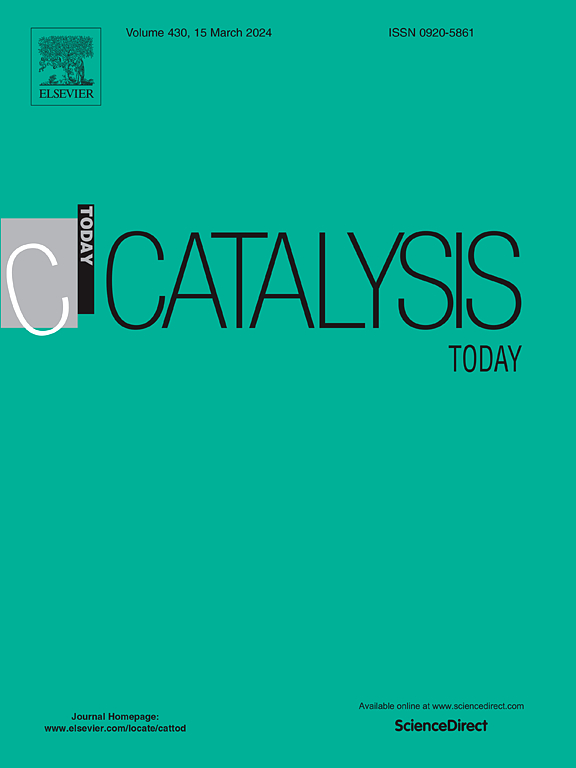Turning waste into value: Iron-cobalt bimetallic hydrochar for efficient removal of persistent chlorinated pollutants – Mechanistic insights and adsorption models
IF 5.2
2区 化学
Q1 CHEMISTRY, APPLIED
引用次数: 0
Abstract
In this study, a hydrothermal carbonization process was used to convert maple leaves into hydrochar, a sustainable bio-adsorbent, for the removal of pentachlorophenol (PCP) from wastewater. The hydrochar was further magnetized with iron and cobalt through hydrothermal treatment, enabling easy magnetic separation. Successful synthesis was confirmed by various physicochemical characterization techniques. Magnetic characteristics like saturation magnetization, remanence, and coercivity of synthesized hydrochar were studied to assess the functionalization. A removal efficiency of 94 % was achieved within 30 min at optimized conditions (0.06 g/L adsorbent dose, 10 mg/L initial PCP concentration, and pH 3). The adsorption process followed a pseudo-second-order kinetic model (R2= 0.995). Adsorption capacity decreased with an increasing pH from 3 to 11. At low pH values, the electrostatic interactions between PCP and adsorbent were favored by greater attractive forces. It was also observed that elevated temperature negatively impacted adsorption capacity. Reusability studies revealed a minimal reduction (16 %) in the removal efficiency over five cycles, highlighting the material’s durability. These findings demonstrated that the synthesized magnetic biosorbent effectively adsorbed PCP, and the adsorption capacity was influenced by factors like adsorbent dose, pH of reaction solution, and temperature.
将废物转化为价值:用于有效去除持久性氯化污染物的铁钴双金属碳氢化合物-机理见解和吸附模型
本研究采用水热炭化工艺将枫叶转化为可持续性生物吸附剂烃类,用于去除废水中的五氯酚(PCP)。通过水热处理,将氢炭与铁和钴进一步磁化,使其易于磁分离。通过各种物理化学表征技术证实了合成的成功。研究了合成的碳氢化合物的饱和磁化、剩余力和矫顽力等磁性特征,以评价其功能化程度。在0.06 g/L吸附剂、10 mg/L初始PCP浓度和pH为3的条件下,30 min内的去除率为94 %。吸附过程符合准二级动力学模型(R2= 0.995)。吸附量随pH从3到11的增加而降低。在较低的pH值下,吸附剂与PCP之间的静电相互作用受到较大的吸引力。研究还发现,温度升高对吸附能力有负面影响。可重复使用性研究显示,在五个循环中,去除效率的最小降低(16% %),突出了材料的耐用性。实验结果表明,合成的磁性生物吸附剂对PCP有较好的吸附效果,吸附能力受吸附剂用量、反应溶液pH、温度等因素的影响。
本文章由计算机程序翻译,如有差异,请以英文原文为准。
求助全文
约1分钟内获得全文
求助全文
来源期刊

Catalysis Today
化学-工程:化工
CiteScore
11.50
自引率
3.80%
发文量
573
审稿时长
2.9 months
期刊介绍:
Catalysis Today focuses on the rapid publication of original invited papers devoted to currently important topics in catalysis and related subjects. The journal only publishes special issues (Proposing a Catalysis Today Special Issue), each of which is supervised by Guest Editors who recruit individual papers and oversee the peer review process. Catalysis Today offers researchers in the field of catalysis in-depth overviews of topical issues.
Both fundamental and applied aspects of catalysis are covered. Subjects such as catalysis of immobilized organometallic and biocatalytic systems are welcome. Subjects related to catalysis such as experimental techniques, adsorption, process technology, synthesis, in situ characterization, computational, theoretical modeling, imaging and others are included if there is a clear relationship to catalysis.
 求助内容:
求助内容: 应助结果提醒方式:
应助结果提醒方式:


